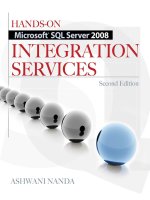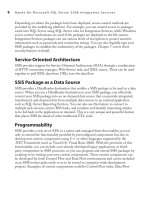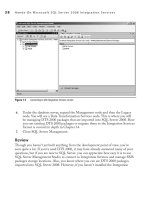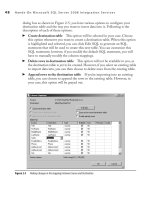Hands-On Microsoft SQL Server 2008 Integration Services part 7 ppsx
Bạn đang xem bản rút gọn của tài liệu. Xem và tải ngay bản đầy đủ của tài liệu tại đây (440.33 KB, 10 trang )
38 Hands-On Microsoft SQL Server 2008 Integration Services
6. Under the database server, expand the Management node and then the Legacy
node. You will see a Data Transformation Services node. This is where you will
be managing DTS 2000 packages that are imported into SQL Server 2008. How
you run existing DTS 2000 packages or migrate them to the Integration Services
format is covered in depth in Chapter 14.
7. Close SQL Server Management.
Review
Though you haven’t yet built anything from the development point of view, you’ve
seen quite a lot. If you’ve used DTS 2000, it may have already answered many of your
questions, but if you are new to SQL Server, you can appreciate how easy it is to use
SQL Server Management Studio to connect to Integration Services and manage SSIS
packages storage locations. Also, you know where you can see DTS 2000 packages
imported into SQL Server 2008. However, if you haven’t installed the Integration
Figure 1-5 Connecting to the Integration Services service
Chapter 1: Introducing SQL Server Integration Services 39
Services as we did in earlier exercise or are trying to connect to an already existing
Integration Services service on a remote server and run into issues, you may like to refer
to the section “Connecting to Integration Services Service” in Chapter 6 to understand
the issues involved in connecting to the Integration Services service.
Summary
You have been introduced to Integration Services by following a couple of simple
Hands-On exercises and reading a description of its architecture, features, and uses.
You understand how various components of Integration Services work together to
provide the manageability, flexibility, and scalability you need for your SSIS packages.
You also appreciate the fact that all the components can be programmatically controlled
and that custom tasks and transformations can be written using languages such as C++
or any CLR-compatible language. You know that Integration Services has two separate
engines that provide workflow and data flow functions. You are now ready to launch
into the realm of bigger challenges.
This page intentionally left blank
Getting Started
with Wizards
Chapter 2
In This Chapter
c
Starting SQL Server Import
and Export Wizard
c
Using Business Intelligence
Development Studio
c
Integration Services
Connections Project Wizard
c
Analyzing Data Quality with
the Data Profiling Task
c
Summary
42 Hands-On Microsoft SQL Server 2008 Integration Services
B
usinesses of today are dealing with customers via a variety of channels—postal
mail, telephone, e-mail, text message, web portal, agent, dealer, direct marketing,
through business partners, and the list goes on. All these channels have their
own systems to support business operations and result into data stored in a variety
of data storage systems using diverse methodologies, and in different geographical
locations. Along with storage requirement considerations, the sheer volume of data can
be overwhelming.
Data must be integrated from all disparate sources rapidly within the organization to
help it better understand its customers. It is the job of information analysts to integrate
data stored in disparate sources. The toolset used to implement data consolidation are
commonly known as extraction, transformation, and loading (ETL) tools. SQL Server
Integration Services (SSIS) makes the job easy by providing various components that
work with most of the data sources and the data stores, and transform data to meet
even the most complex requirements.
However, before you jump-start the data integration process, it would be wise to
understand the underlying issues with your data. Information is critical but only if
accurate. To merge data from different sources, you should make sure that the data is
accurate and consistent. Integration Services 2008 provides a Data Profiling Task to
profile and analyze such data quality issues. This task generates statistical information
in XML format that can be reviewed using Data Profile Viewer. After reviewing the
statistical information and taking the corrective actions, you are ready to integrate your
data streams.
The SQL Server Import and Export Wizard is the easiest utility to help you move
data around. Its interactive and simple graphical user interface (GUI) allows even
beginners to use the wizard for learning purposes and simple package development.
Seasoned developers also use it for creating basic packages quickly, to be later extended
using Business Intelligence Development Studio (BIDS) to reduce development time.
The wizard is designed to perform simple tasks quickly and easily; hence it has limited
transformation capabilities.
In this chapter you will study
e SQL Server Import and Export Wizard
c
e Integration Services Connections Project Wizard c
e Data Profiling Task and Data Profile Viewer c
As the Data Profiling Task works with the data saved in SQL Server 2000 and later,
you will be using SQL Server Import and Export Wizard to import data first in SQL
Server and then will use Data Profiling Task to analyze the quality of data. This should
be your standard practice even in real life while working with Data Profiling Task.
Chapter 2: Getting Started with Wizards 43
Starting SQL Server Import and Export Wizard
While you can use the SQL Server Import and Export Wizard to import and export
data from any SQL Server database, the wizard can also move and transform data that
may or may not involve SQL Server.
SQL Server Import and Export Wizard is handily available at locations where you
would need it. Following are the locations from where you can start the wizard:
DTSWizard.exe file
c
Microsoft SQL Server 2008 program group c
SQL Server Management Studio c
Business Intelligence Development Studio (BIDS) c
The behavior of SQL Server Import and Export Wizard varies slightly based on the
location from where you start it. You will use different methods to start SSIS Import
and Export Wizard while working in the following exercises. Before we progress
further, install the software provided for the exercises in the book. Please refer to the
Appendix for further details on this.
Hands-On: Importing a Flat File into SQL Server 2008
In your first exercise, you will import a simple text file into SQL Server 2008 and create
a new database while importing this file.
1. Choose Start | Run. In the Run dialog box’s Open field, type DTSWizard; then
click OK to open the SQL Server Import and Export Wizard’s Welcome page,
as shown in Figure 2-1. (You can also run this file from the command prompt or
by double-clicking the DTSWizard.exe file in the default location of C:\Program
Files\Microsoft SQL Server\100\DTS\Binn.)
2. Click Next to open the Choose A Data Source window. By default, the wizard
is set to point to a (local) server using SQL Server Native Client 10.0. Click the
down arrow next to the Data Source field to see the other available data sources
to which this wizard can connect. The drop-down list shows providers for several
data sources that are installed on the local machine, including the following:
Flat Files
c
Microsoft Excel c
Microsoft Access c
.NET Framework Data Provider for Oracle c
44 Hands-On Microsoft SQL Server 2008 Integration Services
Microsoft OLE DB Provider for SQL Server c
SQL Server Native Client 10.0 c
3. The Import and Export Wizard can connect to and extract data from any of these
data sources. Select Flat File Source from the Data Source drop-down list. The
options on screen change to match the Flat File Source requirements.
4. Click the Browse button next to the File Name field, and in the Open dialog
box navigate to the C:\SSIS\RawFiles folder. Select the CSV files (*.csv) as
the file type to display .csv files, and then choose the RawDataTxt.csv file and
click Open. You’ll see that most of the options in the flat files fields will be
automatically filled in for you as the wizard reads the file format.
5. Click the Column names in the first data row check box option, as shown in
Figure 2-2, and then click Columns in the pane on the left.
On this page, data is listed in the bottom half of the window. Note that the
Column delimiter is Comma by default and that the headings of columns are
displayed properly and are actually picked up from the first row of the text file.
Figure 2-1 The Import and Export Wizard’s Welcome page
Chapter 2: Getting Started with Wizards 45
Go to the Advanced page by clicking it in the left pane. You’ll see the list of
columns in the middle pane and the column properties for the selected column
in the right pane. You can change column properties such as Data Type or
OutputColumnWidth here. To help you quickly identify the data types and
length of the columns in the flat file a Suggest Types button has been provided.
Click Suggest Types to see the options available in the Suggest Column Types
dialog box shown in Figure 2-3. If you feel that the data types suggested by the
flat file adapter are not correct, the most likely reason is that the flat file adapter
didn’t sample enough rows to guess it right. You can change this in Number Of
Rows box by increasing the number of rows to sample up to a maximum of 9999.
Note that if you choose a very large number here, the flat file adapter will take
more time to suggest data types and you still must check that the appropriate
column lengths and data types have been selected. Review the other options and
click Cancel to come back.
Figure 2-2 Selecting a data source in the SQL Server Import and Export Wizard
46 Hands-On Microsoft SQL Server 2008 Integration Services
Finally, if you click Preview, you will be able to set a value in the Data Rows to
Skip field. Click Next to move on.
6. In the Choose a Destination window, leave the default SQL Server Native Client
10.0 selected in the Destination field. Microsoft SQL Server Native Client 10.0
provides an OLE DB interface to Microsoft SQL Server databases and supports
several new features added to SQL Server 2008 such as Table-Valued Parameters,
FILESTREAM, Large CLR UDTs, Sparse Columns, extended Service Principal
Names (SPN) support, and Date and Time improvements.
Just to remind you once again, you don’t need to have SQL Server to run the
SQL Server Import and Export Wizard or BIDS for developing Integration
Services packages. You can actually move or transform your data from any source
to any destination without involving SQL Server. So, for example, you can choose
Destination as a text file and remove some of the columns from the destination
file (so that you generate a modified text file from a text file), one operation that
isn’t easy to perform on text files otherwise.
You can specify your server name in the Server Name field or select a name from
the drop-down list by clicking the down arrow. Leave (local) specified for this
exercise and leave the radio button for Use Windows Authentication selected.
In the Database field, either you can specify a database name or you can opt to
create a new database. The software provided for the book contains files for the
Campaign database that you will use to perform various exercises. Please refer
to the Appendix for further details on this. If you haven’t attached the provided
Campaign database yet to your SQL Server database engine, you can create it
here by clicking the New button. Click New to create a new database.
Figure 2-3 Specifying a number of rows to sample appropriately
Chapter 2: Getting Started with Wizards 47
7. If your login for SQL Server is correct, a new Create Database dialog box will
open. Note that even if you can connect and open this dialog box, you still are
required to have appropriate permissions on the SQL Server to create a new
database; otherwise you’ll a get create database permission denied error when
you click OK to create a new database. Type Campaign in the Name field. The
wizard will complete the rest of the details using the default database options
similar to those shown in Figure 2-4. Leave the default options as is, and click
OK to create the Campaign database. Note that if you’ve already attached the
Campaign database provided with the software for this book, then you do not
need to create the Campaign database here. Click Next to proceed.
8. In the Select Source Tables And Views window, verify that the check box next to
the filename listed under Source is selected. The Destination will automatically
be filled in with a table name. Click Edit Mappings. In the Column Mappings
Figure 2-4 Creating a new database in the SQL Server Import and Export Wizard









